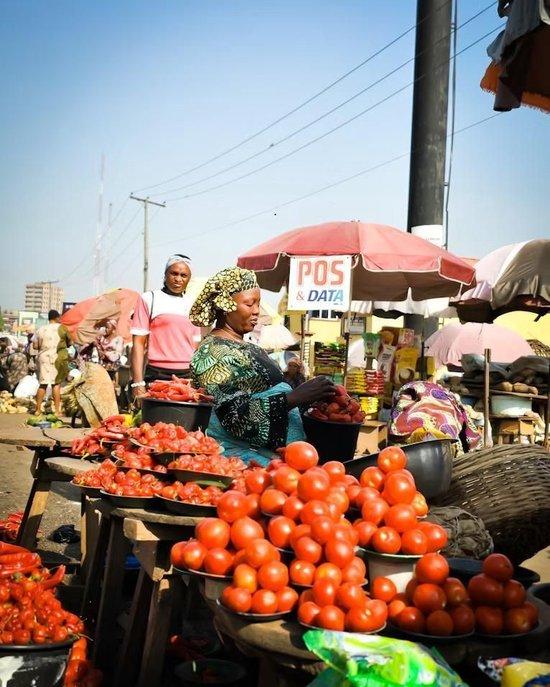




“Recently, we’ve noticed that many sellers from European and American e-commerce platforms, as well as those from Southeast Asian platforms, are all keenly exploring the African market. Jumia’s recent investment conference in Shenzhen was expected to attract 300 attendees, but ended up with 450; last year, our live broadcasting conference had an online audience of just a few thousand, but this year it soared to five hundred thousand. This clearly demonstrates the enthusiasm for the African market among everyone.”
Linli, the head of China for Jumia, told Xiaguang Society that the African e-commerce market has recently seen a surge in popularity, attracting numerous Chinese sellers.
Data is even more vividly demonstrating the increasing trade between China and Africa. According to data released by the General Administration of Customs on June 9th, affected by the US-China trade war, China’s exports to the United States continued to deteriorate in May, with a year-on-year decline expanding by 13.6 percentage points to 34.6%, marking a significant slowdown for two consecutive months; China’s exports to Japan slowed down by 1.6 percentage points to 6.1%; while in developed economies, only exports to the EU saw an acceleration, with a year-on-year growth rate climbing by 3.7 percentage points to 11.9%.
In emerging economies, China’s exports to Africa increased by 33.4% year-on-year, higher than the previous value of 7.3 percentage points. However, exports to ASEAN and Latin America slowed down by 6.0 and 14.2 percentage points to 15.0% and 2.6%, respectively, and exports to Russia saw a year-on-year decrease expanded by 8.6 percentage points to 11.0%.
“Due to the tense trade relations between China and the US, many Amazon sellers have started considering moving to other countries; meanwhile, competition in Southeast Asia is intensifying and there’s a severe phenomenon of involution, reducing profit margins. In the global blue ocean markets,
we always say that e-commerce in Africa is like Taobao twenty years ago
, with simpler operations and lower barriers to entry, which makes more sellers want to try and the cost of trial and error is not high,” Linli said.
Amidst the global downturn in consumption, African e-commerce is welcoming Chinese sellers with vigorous growth.
The large youth population is the most crucial premise for the promising future of the African e-commerce market.
In today’s world where global aging continues to intensify, Africa, with an average age of only 19.3 years old, stands as the youngest region in the world—in contrast, China has a population average age close to 40, while Europe is around 45; about 60% of the African population is under 25 years old, and more than one third are between 15 and 34 years old. According to Worldometer data, by 2025, the African population is estimated to be around 1.549 billion, second only to Asia, making it the second largest continent in terms of total population.
Unlike the declining birth rates in Asian countries, the African population continues to grow rapidly. The population in Sub-Saharan Africa grows at an annual rate of 2.7%, which is more than double that of South Asia (1.2%) and Latin America (0.9%). This means that every two years, Africa will have added the population of France or Thailand.
Most experts agree that
by 2050, the African population will reach 2.5 billion, meaning over a quarter of the world’s population will reside in Africa, potentially marking the beginning of an “African century” in human civilization.
“Currently, the penetration rate of e-commerce in Africa accounts for only 2%-5% of total retail sales, whereas in China it is 20%, indicating significant room for growth in Africa,” Linli said.
Meanwhile, African countries like Nigeria, characterized by their emerging middle class and gradually increasing consumption capabilities, stand out.
According to statistics from the United Nations Office on African Affairs, by 2060, the population of the middle class in Africa could potentially increase to over 40% of the continent’s total population. This demographic shift presents an exceptional opportunity for accelerating industrialization in Africa and paves the way for the Fourth Industrial Revolution.
“The rise of the African middle class has become a driving force behind Africa’s economic growth, marking an important milestone in the history of contemporary African economics. Despite the uneven development, this growth brings hope to Africa, also conveying prospects for economic recovery and revival to other parts of the world, especially during times of global economic downturn when the African economy continues to maintain stable growth,” said Mumbi Nkumbula, Chief Economist at the African Development Bank Group, in her book “African Emerging Middle Class.”
It is worth noting that Africa is one of the regions with the most extreme wealth gap in the world, with different classes living in spaces that are mutually isolated and separated. The wealthy areas may be just a step away from the slums, yet they seem like two different worlds. The wealthy areas often have real guns and guards to secure their property, solidifying the class barrier through physical separation.
Peking University scholar Cheng Ying describes the social structure in South Africa characterized by “isolation capacity” as follows: it refers to having enough financial resources to ensure families can completely disconnect from infrastructure and public systems, such as sending children to private schools, purchasing private medical insurance for the whole family, owning their own power and water supply systems in their backyards, etc.
Targeting the middle and high-income groups, products with high unit prices and high customer value offer more ample profit margins. After all, for African e-commerce, high return rates and hefty shipping costs pose significant operational challenges. In contrast, platforms tend to encourage the entry of products with high unit prices and low return rates.
South Africa’s famous port city, Cape Town, is showcased.
If the burgeoning middle class has driven prosperity in consumption, then the rise in smartphone penetration and the growth of internet users have further expanded the scale of e-commerce.
According to the “Media Dependence Theory” proposed by American scholar De Vries, impoverished areas face limitations in accessing real-world resources such as education, employment, and healthcare. Individuals are more likely to seek information online (such as job hunting or educational resources), social support (alleviating real loneliness), or entertainment escape (shifting anxiety about poverty) through the internet, thus forming a functional dependence on the network.
The addiction to the internet in African regions perfectly reflects this point. A survey conducted by UNESCO in 2021 revealed that among young people in sub-Saharan African impoverished areas, 67% accessed educational resources through mobile networks. However, 43% of these users spent their time primarily on short videos and social media platforms, presenting a phenomenon of both “instrumental dependence” and “entertainment addiction.”
Therefore, social commerce might become the next hotspot in the African e-commerce market.
“We believe that the future scale of Nigeria’s e-commerce market will be at least ten times larger than it is now,” Tom Hurier, General Manager of Jumia Global, told Xiaguang Society.
Nigeria, with a population of 227 million, has already become the center of innovation in Africa. In 2021, the number of startups in Nigeria grew by 35%; by 2023, five out of seven African tech unicorn companies were from Nigeria.
In the field of financial technology, Nigeria has seen the emergence of giants such as Paystack, Flutterwave, Piggyvest, Moniepoint, and OPay; in the realm of e-commerce, Jumia and Konga, born in Nigeria, have grown into the leading figures in Africa’s e-commerce industry.
Regarding this, Dr. A. John Alfonso, the Swiss and Belgian representative of the Nigerian All Progressive Congress Party, told Xiaguang Society: “On the African continent, Nigeria’s comparative advantage lies in its scale, talent, and integration of innovation. Lagos, as the commercial hub of Nigeria, has developed into a leading innovation center. It integrates an active entrepreneurial culture, continuously improving venture capital channels, a growing pool of tech talent, and a developing network of incubators and accelerators. Compared to many other African countries, Nigeria embraced mobile banking, digital commerce, and technology-driven solutions earlier, enabling it to expand more rapidly and create startups with global competitiveness.”
On May 28, 1975, the Economic Community of West African States was established in Lagos, Nigeria, where member states implemented tariff exemptions among themselves.
This arrangement allowed companies based in Lagos to reach over four hundred million consumers across West Africa.
The cityscape of Lagos, Nigeria
This year, in the Financial Times Africa’s fastest-growing companies ranking, 23 out of Nigeria’s 28 companies are located in Lagos. The co-founder of fintech startup PiggyVest, Odunayo Eweniyi, mentioned that one of the reasons for the company’s move to Lagos is its size.
This rapidly developing metropolis is one of the world’s largest cities and also the largest in Sub-Saharan Africa, with over two million people converging here, accounting for 10% of Nigeria’s total population.
“If you are popular in Lagos, you will be popular in Africa; this is the best starting point for testing and expanding your product.”
Odunayo Eweniyi said.
“Currently, even traditional markets in Nigeria are beginning to accept WhatsApp orders, mobile banking, and delivery networks. Moreover, the emerging middle class is increasingly focused on value and branding. Additionally, younger consumer groups, who are more proficient in mobile devices and culturally influential, lead trends through social media, influencer marketing, and online reviews. Companies that can quickly respond to these signals (especially through platforms like Instagram, TikTok, or local apps) will achieve great success in the highly competitive consumer market in Nigeria.” Dr. A. John Alfonso told the Xinhua News Agency.
A vibrant scene at the Ibadan Bodija Market in Nigeria
Discussing which sellers are suitable for the African market, Linli, the China head of Jumia, mentioned that Jumia currently focuses on recruiting sellers with operational experience on mainstream cross-border platforms such as Shopee, Ladaza, AliExpress, SHEIN, Temu, Noon, Ozon, etc., or sellers with offline African channels and products suitable for cross-border trade. In terms of categories, men’s and women’s clothing, children’s wear, personal care, home goods, automotive accessories, and electronics continue to sell well in the African market.
Africa and Southeast Asia, these markets share many similarities in terms of e-commerce consumption.
Firstly, the average transaction value is quite close; secondly, we’ve found that many hot products from Southeast Asia are also popular in Africa; additionally, both regions have a significant Muslim population, which brings about cultural similarities. “Linli said,” Linli added.
At the same time, Linli mentioned that if sellers focus on the high-end market in Europe and America for an extended period, their brand positioning and pricing might not be very suitable for the cost-sensitive African market at this stage. “Amazon sellers are not very well-suited to the African market in terms of product and price. Unless they are factory-type sellers, they may have higher profit expectations, with average transaction values of over a hundred dollars and profit margins of more than twenty percent; however, Jumia’s overall average transaction value is around 8-15 dollars. These sellers might not last long before actively exiting,” Linli stated.
The African market itself is not a monolithic entity. This land comprises 54 countries, making it the continent with the most countries, and different countries and regions have varying consumption capabilities, preferences, and habits. “In Egypt, shoppers crave brand electronics and cosmetics; in Nigeria, consumers have a strong demand for essential goods and value-for-money items; in Kenya, convenience and integrated mobile payment services are crucial,” Tom Hurier told Xiaguang Society.
Logistics undoubtedly poses a major challenge to the development of e-commerce in Africa. On the entire African continent, only 43% of roads are paved, with 30% located in South Africa. Due to poor road conditions, the last mile delivery costs in Africa can reach up to 35-55%, whereas China’s data for the same metric is 5%-8%.
These pain points are accompanied by solutions that have emerged.
Currently, the African urban delivery network is thriving, with numerous mobile applications based on crowdsourcing models emerging, such as Kwik in France, Sprint in Egypt, and Sendy, WumDrop, MAX, Rush, Glovo, Pick-it, and Busy Bora.
To minimize the logistics delivery time as much as possible, Jumia has ceased its recruitment for direct mail merchants, focusing entirely on overseas warehouse sellers. After consumers place orders, the platform ships from the warehouse, and goods can be delivered within 1-2 days to their hands. In remote areas where contact is difficult, Jumia has established community pickup points to reduce the cost of “last mile” delivery. Tom Hurier mentioned that in Abidjan, the economic capital of Côte d’Ivoire, local pickup points have significantly increased order volume in rural areas.
However, if direct mail is adopted, air freight costs are too high, and compared to the global average, customs clearance in Africa may take up to 30% longer, resulting in a delivery cycle of 15-20 days, which significantly slows down overall payment collection efficiency, leading to poor experiences for both consumers and sellers.
Moreover, cash on delivery remains the mainstream payment method for e-commerce shopping in Africa. Today, there are also some financial technology companies emerging in Africa that specifically address the coverage gap of traditional financial services. For example, M-Pesa, launched in Kenya in 2007, provided digital finance for millions of Africans, with its transaction volume once accounting for 40% of Kenya’s entire national GDP, positively impacting Kenya’s GDP by 20%-30%.
This blue ocean market also harbors excellent opportunities. Linli said,
Jumia always encourages Chinese sellers to create their own brands through e-commerce platforms. “It’s very easy for a brand to enter the African market.”
Currently, Africa primarily utilizes offline promotional methods for brand exposure; the cost of online marketing is also quite low, and we have also created special brand days for brands. Africans do not have a very mature concept of branding, so any brand can grow rapidly in the African market. For instance, a previous laptop seller grew to be a top seller within this category in just three months.
In the view of Tom Hurier, General Manager of Jumia Global, the biggest challenge for Chinese sellers venturing into the African market is often psychological.
“Many Chinese sellers hesitate because Africa feels unfamiliar or risky to them. However, the reality is: Africa has tremendous potential, and the barriers are lower than they think. African consumers are eager for high-quality, affordable products, and competition in many categories remains limited.”
Dr. A. John Alfonso believes that as the e-commerce market in Africa matures, growth will no longer rely solely on channels but will focus on depth, differentiation, and localization. To maintain competitiveness and create long-term value, Chinese sellers need to transition from exporters to brand embedders. “Investing in local businesses, such as setting up offices or light industry assembly plants. Building a brand image by telling local stories, influence marketing, and corporate social responsibility participation can significantly enhance visibility. Collaborating with experienced Nigerian companies—whether in distribution, logistics, or retail—can ensure smoother operations and stronger market access.”
Ultimately, brands rooted in their homeland will be more successful than those solely dependent on low prices.
In Lagos, fruit vendors
In 2012, a team of South African anthropologists, Jean and John Comaroff, in their book “Theory From the South,” proposed an important perspective:
It’s not Africa that is catching up to Europe and America; on many levels, the world is becoming more African.
This viewpoint has been repeatedly validated to this day. Globally, the increasingly widening wealth gap, class divide, and racial tensions are exacerbating societal divisions and disagreements. However, in Africa, these contradictions are manifested in more extreme forms. As the world becomes increasingly “Africanized,” consumption undoubtedly serves as a most concrete mirror, reflecting the structural characteristics and developmental dilemmas of this increasingly fragmented world. (Xiaguang Society’s e-commerce market observation series articles include: “Japan Stagnates for 35 Years, Entering ‘China Moment’,” “Power Outages Produce Business Opportunities, Chinese Brands ‘Light Up’ Spain,” “Rising in Russia E-commerce,” “Cross-border Sellers’ ‘Death’ and ‘Life’ Shift from America to Europe,” “Middle East Ramadan Consumption: Wealth Inequality, Fitness Wave, National Products Gain Popularity,” “Making 5 Billion in Brazil, They Just Want to Quietly Make Money Bigger,” “Chinese E-commerce Force, Vanishing into the World’s Fourth Largest E-commerce Market”)
Unlike other regions facing the impact of global aging, which are becoming increasingly “old and poor,” Africa remains a very young land. Can the consumption landscape on this land bear our hopes and expectations for the “last blue ocean”? Xiaguang Society will continue to pay attention to the consumption dynamics in Africa’s e-commerce.